Key takeaways:
- Butterflies play a crucial role in pollination, supporting biodiversity and ecosystem health, making their conservation vital.
- Creating suitable habitats and selecting native plants are instrumental in attracting butterflies and other pollinators.
- Sustainable gardening practices, such as composting and using organic pest control, enhance garden health and support wildlife.
- Personal observation and community engagement are key elements in understanding and promoting butterfly conservation efforts.
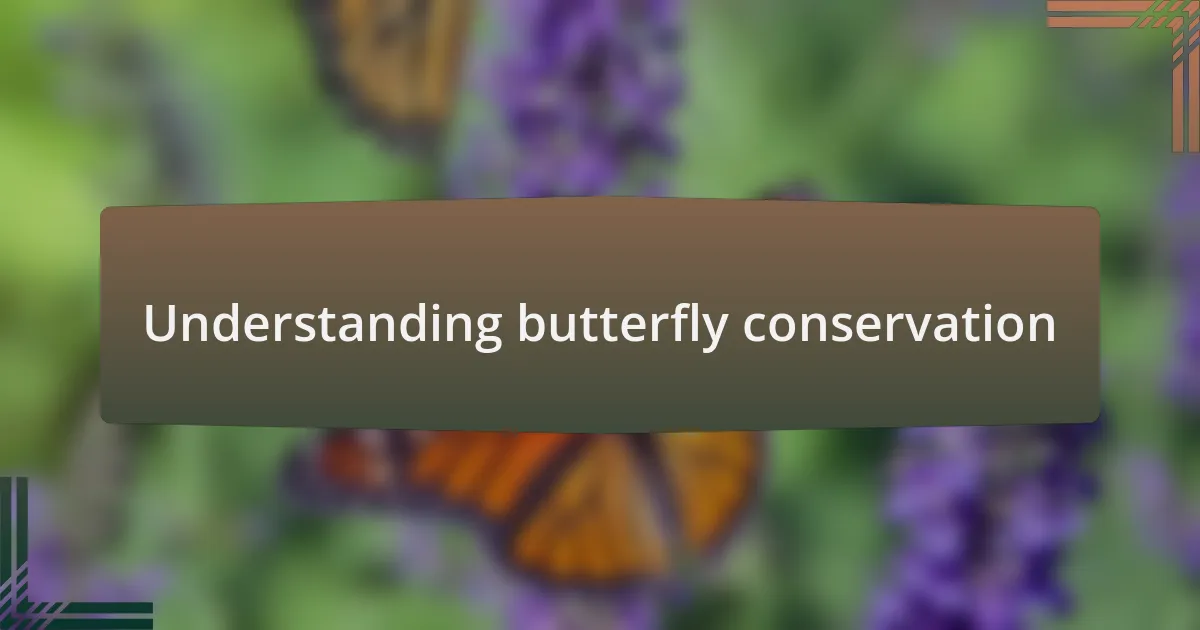
Understanding butterfly conservation
Butterfly conservation is vital for maintaining biodiversity and ecosystem health. I remember the first time I spotted a Monarch fluttering through my garden; it was a moment of pure joy that reminded me of the intricate relationships within nature. Each butterfly plays a role in pollination, supporting not just their species but countless plants and animals.
Understanding the life cycle of butterflies is essential for successful conservation efforts. I’ve often pondered why we sometimes neglect such delicate creatures, despite their beauty and the crucial role they play in our gardens. From caterpillar to chrysalis, every stage is a reminder of resilience and transformation, urging us to protect their habitats.
We must consider the threats butterflies face today, from habitat loss to climate change. I was heartbroken when a treasured flower patch I tended was replaced by pavement, erasing a place where I once saw dozens of butterflies. How can we engage our communities in conservation efforts, ensuring future generations can experience the same wonder? It starts with awareness and action, both of which we can foster together.
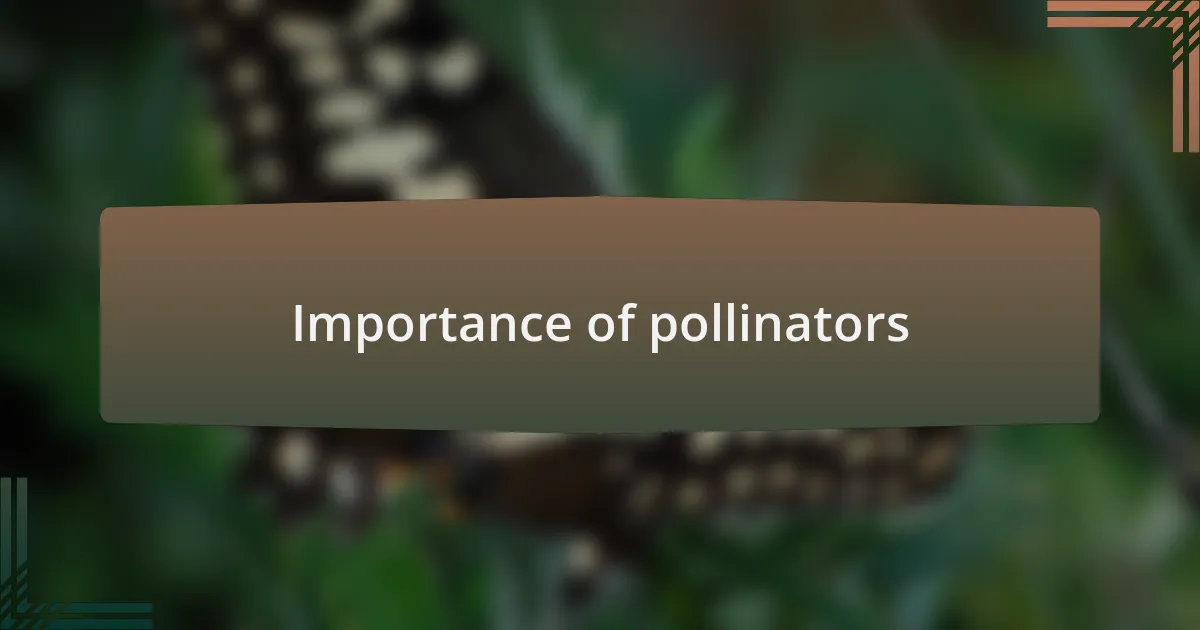
Importance of pollinators
Pollinators, including butterflies, bees, and other insects, are essential for the success of many flowering plants and the production of fruits and vegetables. I recall standing in my backyard surrounded by blooming wildflowers, marveling at the flurry of activity as various pollinators danced from blossom to blossom. It struck me how vital they are—not just for our gardens, but for the larger agricultural systems that feed us.
When I reflect on a time when a friend shared her struggles with growing strawberries, I realize just how crucial these tiny creatures are. Without adequate pollination, her plants flourished in leaves but bore no fruit. This made me think: what would our world look like if we didn’t encourage and protect pollinator populations? Our health, economy, and ecosystems depend on their role in maintaining plant diversity.
As I nurture my pollinator-friendly garden, I can’t help but feel a deep connection to these remarkable beings. Watching a butterfly settle on a flower isn’t just beautiful; it’s a reminder that their efforts sustain the balance of nature. Have you ever witnessed that magical moment? It’s a small but powerful experience that highlights the importance of pollinators in ensuring a thriving environment for all life forms.
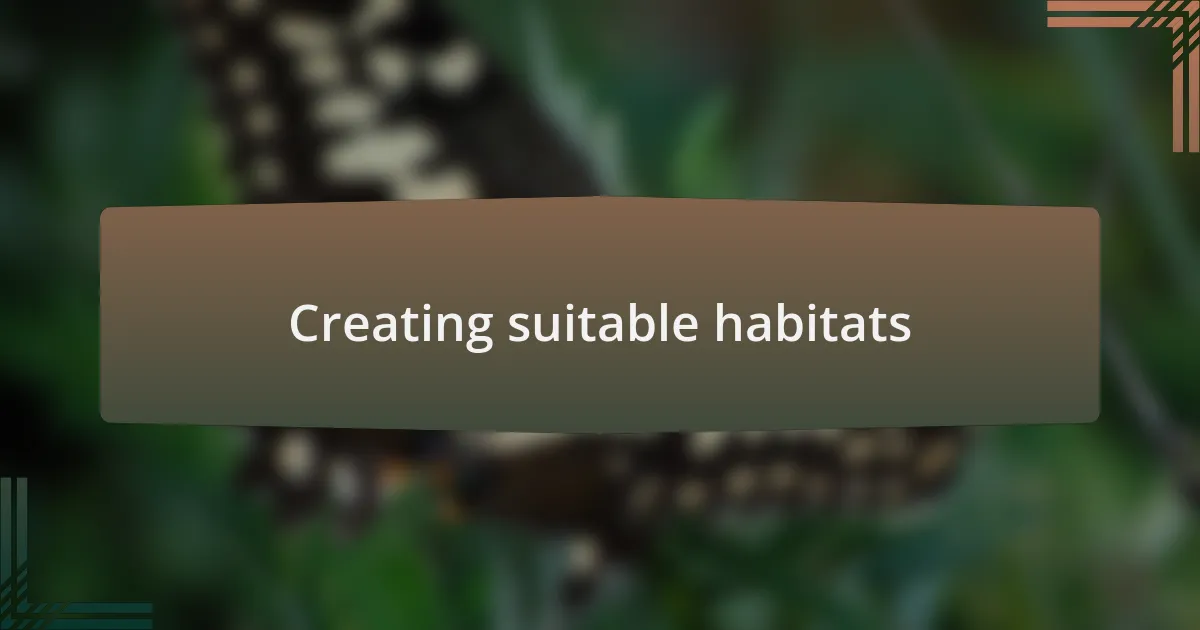
Creating suitable habitats
Creating suitable habitats for pollinators is a rewarding journey that starts right in your backyard. I remember the first time I transformed a small patch of grass into a vibrant wildflower garden. It felt almost magical to see butterflies fluttering in, bringing color and life. Instead of just grass, I opted for native plants that attract these beautiful creatures, and it truly made a difference.
The layout of the garden can have a significant impact, too. I made sure to include sunny spots and sheltered areas, as I’ve learned that butterflies love basking in the sun while occasionally seeking shade. Have you thought about how changing the landscape might invite more pollinators into your space? When I rearranged the flowers to create clusters, I was amazed at how quickly the visitors arrived, proving that even small changes can enhance the environment.
Providing a water source is another simple yet effective way to support pollinators. I noticed a shallow dish filled with pebbles and water became a tiny oasis for both butterflies and bees in my garden. It’s fascinating to observe them drinking peacefully, reminding me that even the smallest corner of our spaces can hold the key to flourishing habitats. Have you ever wondered how something so simple can create such a welcoming environment? The beauty is in the details, and our efforts can yield remarkable results.
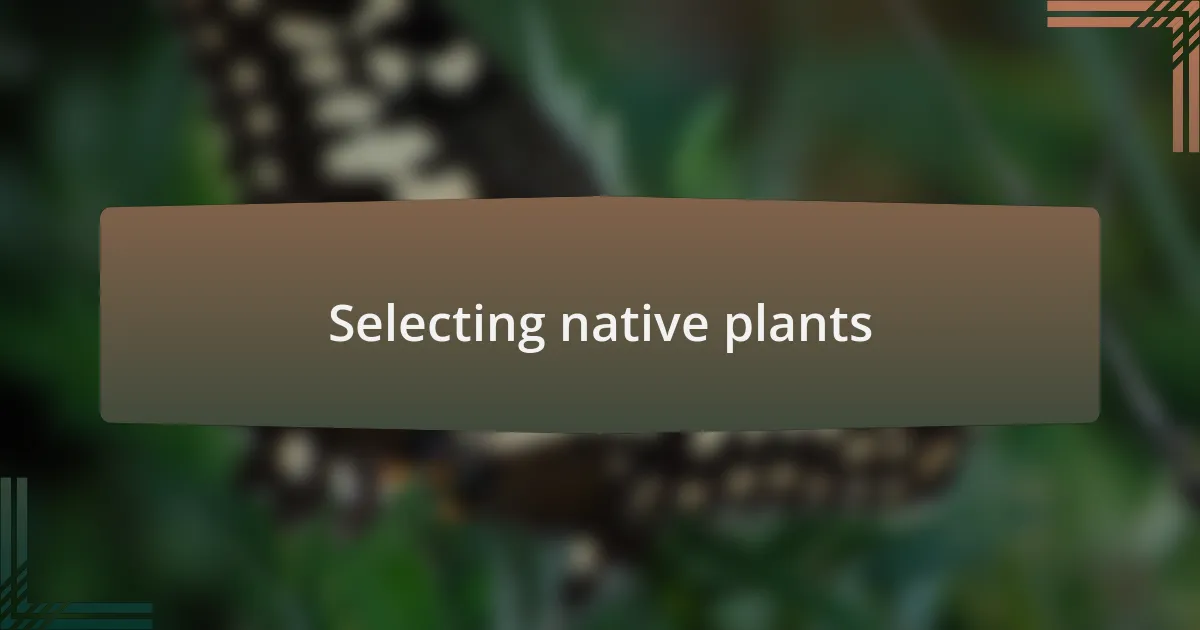
Selecting native plants
When it comes to selecting native plants, I’ve found that focusing on the local ecosystem is key. I remember my first visit to a native plant nursery, and I was astonished by the variety of options that thrived in my region. Choosing these plants isn’t just about supporting pollinators; it’s a way to connect to the natural landscape that surrounds us. Have you ever noticed how certain flowers seem to attract specific butterflies? That’s the magic of native plants—they’ve co-evolved with the wildlife in your area.
I particularly cherish planting milkweed, as it draws in monarchs like a magnet. The first time I spotted a female butterfly laying eggs on my milkweed leaves, I felt a sense of pride and joy that was unparalleled. It was like welcoming a special guest into my garden, knowing I was providing a crucial resource for their lifecycle. Do you have a favorite native plant? Each one tells a story of adaptability and resilience, making your garden a unique sanctuary.
Additionally, the blooming seasons of native plants often align perfectly with the life cycles of local pollinators. In my garden, I made it a point to select plants that flower at different times, ensuring that there is always something in bloom. The thrill of seeing butterflies emerge throughout the growing season brings such delight. Every week, I discover new visitors that I hadn’t seen before, showcasing how thoughtful plant selection can create a vibrant, ever-changing tableau right outside my window.
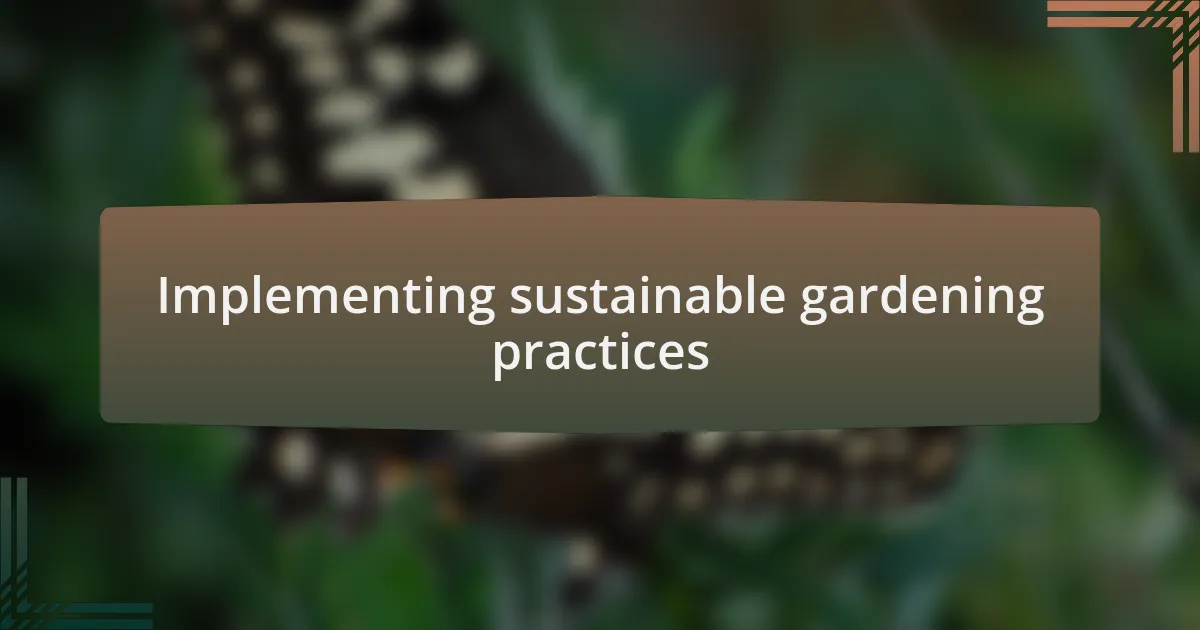
Implementing sustainable gardening practices
Sustainable gardening practices not only support wildlife but also enhance the overall health of your garden. When I first started composting kitchen scraps and yard waste, I was amazed at how quickly my soil transformed into nutrient-rich goodness. Have you ever witnessed the vibrant, dark-tinged earth that results from composting? It’s like giving your plants a health boost that truly pays off, fostering an environment that flourishes with life.
Incorporating organic methods into pest management is another essential aspect. I remember when aphids began to invade my garden—my instinct was to reach for chemicals. Instead, I took a more eco-friendly approach by introducing ladybugs, nature’s little pest control agents. Watching them work their magic became a source of fascination for me. It’s incredible how we can find harmony in nature if we take a moment to embrace organic solutions. Have you ever tried using beneficial insects in your gardening? The results can be stunning and much more gratifying!
Water conservation is also a critical consideration in sustainable gardening. Early on, I invested in rain barrels to collect runoff from my roof, and it has been one of my best decisions. I often find myself feeling a sense of accomplishment each time I use that water to nourish my plants. It’s a simple practice that not only saves on utility bills but also supports the ecosystem. When was the last time you thought about the impact of your watering habits? Small changes can lead to significant benefits for our gardens and the pollinators that thrive within them.
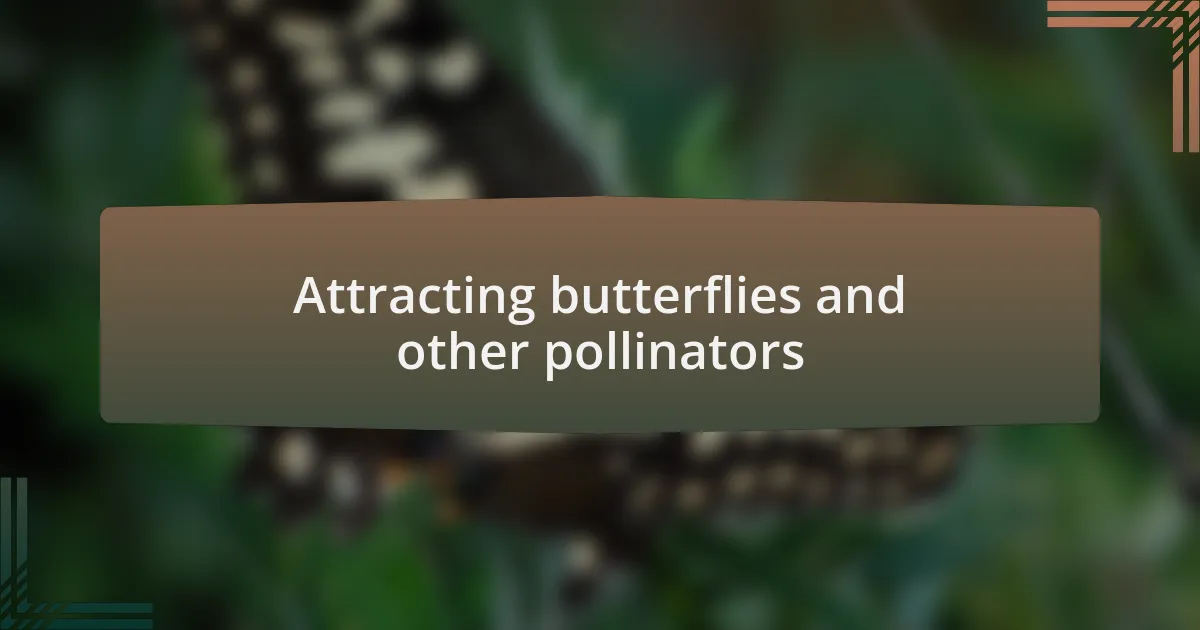
Attracting butterflies and other pollinators
To attract butterflies and other pollinators, I’ve found that planting a diverse selection of native flowers can work wonders. There’s something truly satisfying about watching these creatures flutter from bloom to bloom, each vibrant petal beckoning them with a promise of nectar. Have you ever stood quietly in your garden and felt the gentle buzz of life around you? It’s like nature is inviting you into its colorful dance.
One of my favorite strategies is to create a sunny spot filled with nectar-rich plants, such as milkweed and coneflowers. I vividly recall the first time a swarm of butterflies visited—my heart swelled with joy as they gracefully explored the garden. It’s in those moments that I realized how our efforts can create a sanctuary for these delicate beings. Have you seen how a patch of wildflowers can transform a plain space into a vibrant paradise?
Additionally, I’ve learned that providing shelter can make my garden even more inviting for pollinators. I decided to leave certain areas somewhat untamed, with dense foliage and brush. This not only gives butterflies a safe place to roost but also encourages other pollinators like bees to establish their homes. It’s remarkable how a little bit of chaos can foster such a flourishing habitat, don’t you think?
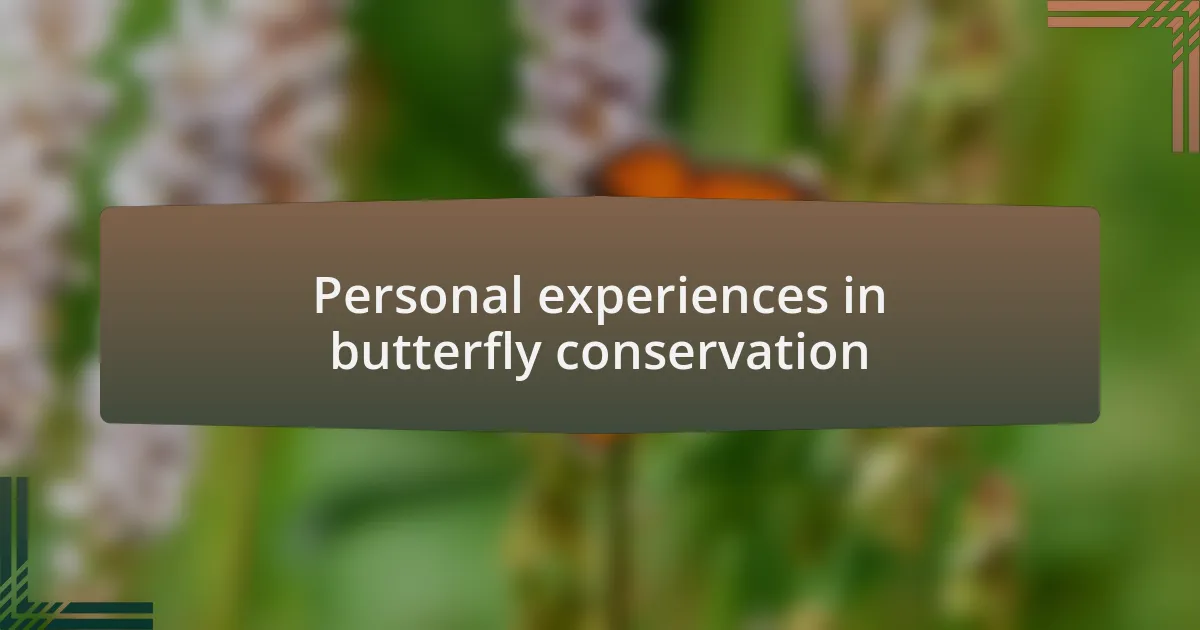
Personal experiences in butterfly conservation
In my journey towards butterfly conservation, I’ve learned the power of patience. One summer day, I decided to sit quietly for a few hours, observing the butterflies in my garden. It was fascinating to see how they interacted with different flowers, teaching me which plants truly provided the best nutrition and support for their lives. Have you ever taken the time to just watch? The more I observe, the more I understand their preferences, leading me to adjust my garden accordingly.
I also experienced a profound moment during a community butterfly count. Joining fellow conservationists, we shared stories and techniques, bonding over our love for these fluttering friends. I still remember one elderly gentleman sharing how his childhood memories of catching butterflies inspired him to create a haven in his own backyard. It struck me how these personal histories intertwine with our collective mission; conservation isn’t just about plants and habitats; it’s about connection—between nature and us.
Creating a butterfly garden has been a learning curve full of surprises. Initially, I struggled with pests, thinking they would deter butterflies. However, I learned to appreciate the intricate balance of the ecosystem. One day, I noticed a caterpillar munching on a host plant I’d almost removed in frustration. I hesitated—my heart raced at the thought of losing a future butterfly. Then I realized: every small creature plays a role in this vibrant community. Have you ever paused to consider the beauty of nature’s balance? It’s a humbling reminder of our role in nurturing the environment.